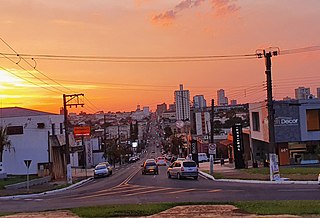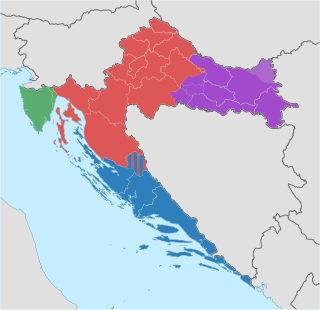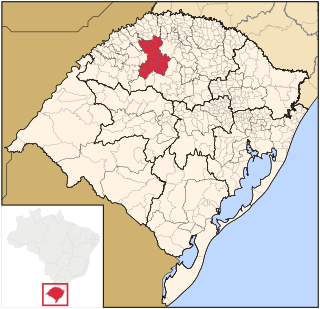Related Research Articles
Mitteleuropa, meaning Middle Europe, is one of the German terms for Central Europe. The term has acquired diverse cultural, political and historical connotations.

Klaus Friedrich Roth was a German-born British mathematician who won the Fields Medal for proving Roth's theorem on the Diophantine approximation of algebraic numbers. He was also a winner of the De Morgan Medal and the Sylvester Medal, and a Fellow of the Royal Society.

Assis is a city and a municipality in the southwestern part of the state of São Paulo in Brazil. The population is 101,409 in an area of 460.61 km2. The town was founded on July 5, 1905, and became a municipality in 1917, when it was separated from Platina. It is the largest city of its microregion, and the 2nd of its mesoregion, and is 434 km away from the capital, São Paulo. The town has an annual average temperature of 21,37 °C, annual rainfall 1,441 mm (56.7 in), and the vegetation predominates Mata Atlântica and Cerrado, is then a transition zone of vegetation. Its Human Development Index (HDI) is 0.805, considered high if compared to state and is in 28th place among Brazilian cities.

Gora is a geographical region in southern Kosovo and northeastern Albania, primarily inhabited by the Gorani people. Due to geopolitical circumstances, some of the local Gorani people have over time also self declared themselves as Albanians, Macedonians, Bosniaks, Bulgarians, Serbs, Turks and Muslims by ethnicity.

The Catalão Microregion is a statistical microregion created by IBGE in south-eastern Goiás state, Brazil. A region of rolling hills and flatlands with extensive cattle raising and soybean plantations. The regional center, Catalão, is growing fast with important industries being installed in the area. The GDP of this region represented almost 5% of the state GDP in 2003.

Campinorte is a municipality in north-central Goiás state, Brazil. The population was 12,764 (2020) in a total area of 1,068 km2.

The Republic of Croatia is administratively organised into twenty counties, and is also traditionally divided into four historical and cultural regions: Croatia proper, Dalmatia, Istria, and Slavonia. These are further divided into other, smaller regions.

The Microregion of Caraguatatuba, often referred as Litoral Norte, is a microregion in the easternmost coastal part of São Paulo State, Brazil. The microregion is bordered by the state of Rio de Janeiro to the east. It is a famous touristic destination, mainly because of the 160 beaches. According to IBGE, Caraguatatuba Microregion has a GDP of R$2,019,94,.048,00 and a population of 281,532 people spread over an area of 1,947.702 km², which means that the density is 144.5/km². The population increases considerably during the summer, because of the tourists.
A microregion was a legally defined area in Brazil consisting of a group of municipalities. They were abolished in 2017 and replaced by Intermediate and Immediate Geographic Regions. Microregions were grouped together into mesoregions. In theory, Brazilian law provided for member municipalities to cooperate on matters of common interest, but in practice, the divisions were used primarily for statistical purposes by the Brazilian Institute of Geography and Statistics.

Santiago is a municipality of the western part of the state of Rio Grande do Sul, Brazil. It is the capital of the microregion of Santiago. The population is 49,360 in an area of 2,413.13 km2 (931.71 sq mi). Its elevation is 409 m. It is located 450 km west of the state capital of Porto Alegre and northeast of Alegrete. The nickname of the city is "The Land of the Poets".

Barroso is a Brazilian municipality located in the south of the state of Minas Gerais. Its population as of 2020 was 20,897 people living in an area of 83 km2 (32 sq mi). The elevation is 920 meters (3,020 ft). The city belongs to the mesoregion of Campo das Vertentes and to the microregion of Barbacena. An important regional center, Barbacena, is located 27 km (17 mi) to the east and is connected by MG-265.

Carrancas is a Brazilian municipality located in the south of the state of Minas Gerais. The city belongs to the mesoregion of Campo das Vertentes and to the microregion of Lavras. In 2020 the population was 4,049 in a total area of 728 km².

Ijaci is a Brazilian municipality located in the south of the state of Minas Gerais. The city belongs to the mesoregion of Campo das Vertentes and to the microregion of Lavras. The population in 2020 was 6,610 in a total area of 105 km². The regional center, Lavras lies at a distance of 14 kilometers and is connected by paved highway MG-335.
A macroregion is a geopolitical subdivision that encompasses several traditionally or politically defined regions or countries. The meaning may vary, with the common denominator being cultural, economical, historical or social similarity within a macroregion. The term is often used in the context of globalization.

Fritz Pfenninger was a Swiss cyclist. He was a specialist in six-day racing, winning a total of 33 events between 1956 and 1970, including 19 with Peter Post.
A mesoregion is a medium-sized region between the size of a city or district and that of a nation. Examples of conceptual mesoregions in Southeast Europe include Epirus, Istria, and Kosovo etc. An example of the official usage of the term is Mesoregion (Brazil), a grouping of municipalities for statistical purposes.

Shopska salad is a cold salad popular throughout Southeastern Europe. It is Bulgaria's most famous salad and national dish, whose colors recall the Bulgarian flag.

The Microregion of Frederico Westphalen was one of the Microregions of the Rio Grande do Sul state, in Brazil. It belonged to the mesoregion of the Noroeste Rio-Grandense. Its population was estimated by the IBGE to be of 175,391 in 2005, divided in 27 municipalities. Its total area is 5,182.529 km². The IBGE has since discontinued the microregion system for population tracking, replacing it with the term "immediate geographic region".

Noroeste Rio-Grandense was one of the seven Mesoregions on the state of Rio Grande do Sul in Brazil. It included 216 municipalities grouped in thirteen microregions. The IBGE has since discontinued the microregion system for population tracking, replacing it with the term "immediate geographic region".

The Microregion of Ijuí was one of the Microregions of the Rio Grande do Sul state, in Brazil. It belonged to the mesoregion of the Noroeste Rio-Grandense. Its population was estimated by the IBGE to be of 183.142 inhabitants in 2005, and it was divided in 15 Municipalities. Its total area was of 5.100,402 km². The IBGE has since discontinued the microregion system for population tracking, replacing it with the term "immediate geographic region".
References
- ↑ p. 18, "What's in a Region? Southeast European Regions Between Globalization, EU-Integration and Marginalization", Klaus Roth, pp. 17 ff. in Region, Regional Identity and Regionalism in Southeastern Europe, part I, Klaus Roth and Ulf Brunnbauer, eds., Ethnologia Balkanica11 (2007), LIT Verlag, Münster, ISBN 3-8258-1387-8.